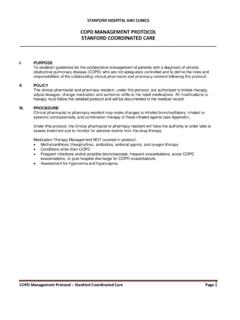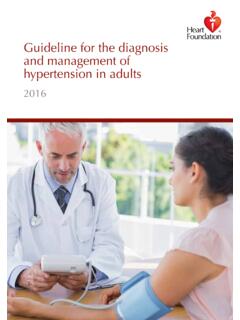Transcription of Work-related Chronic Obstructive Pulmonary Disease in ...
1 Work-related Chronic Obstructive Pulmonary Disease (COPD) statistics in Great Britain, 2021 December 2021 Work-related Chronic Obstructive Pulmonary Disease (COPD) statistics in Great Britain, 2021 1 Contents Chronic Obstructive Pulmonary Disease (COPD) summary 2 Background 3 COPD attributed to occupational exposures 4 Estimated burden of COPD attributable to work 4 Occupational exposures implicated in COPD 4 Compensation claims and other data sources 5 Annex 7 National mortality data for Chronic Obstructive Pulmonary Disease (COPD) 7 References 10 Work-related Chronic Obstructive Pulmonary Disease (COPD) statistics in Great Britain, 2021 2 Chronic Obstructive Pulmonary Disease (COPD) summary COPD is a serious long-term lung Disease which is common in later life and mainly caused by smoking.
2 However, past occupational exposures to various dusts, fumes and vapours have also contributed to causing a substantial proportion of current cases. Chronic bronchitis and emphysema are common types of COPD. These are conditions in which the flow of air into the lungs is gradually reduced by damage to the lung tissue and air passages. Estimates of the proportion of total COPD cases or deaths where occupational exposures have contributed are uncertain and vary across a wide range of epidemiological studies. A number of reviews have estimated values of around 15%, equivalent to about 4,000 deaths per year in Britain. COPD in former coal miners has been recognised for Industrial Injuries Disablement Benefit (IIDB) for a number of years based on clear evidence of an increased risk among these workers.
3 Other workplace exposures likely to contribute to COPD include various dusts (including grain and silica) as well as certain fumes and chemicals (including welding fume, isocyanates, and polycyclic aromatic hydrocarbons). The document can be found at: Work-related Chronic Obstructive Pulmonary Disease (COPD) statistics in Great Britain, 2021 3 Background Chronic Obstructive Pulmonary Disease (COPD) is a term used to describe a progressive and irreversible limitation in airflow in the lungs. COPD includes two main diseases: Chronic Bronchitis: a condition in which inflammation narrows the air passages within the lungs (bronchi) and causes Chronic bronchial secretions; and Emphysema: a permanent destructive enlargement of the airspaces within the lung without any accompanying fibrosis of the lung tissue.
4 Asthma may also be included within the term COPD if there is some degree of Chronic airway obstruction. COPD is a long-latency Disease , which means that cases tend to develop a number of years after first exposure to causative agents. In many cases, symptoms manifest during mid-life or later. The most important causative factor is smoking, but others include occupational exposures to fumes, chemicals and dusts, as well as genetic susceptibility and environmental pollution [1]. COPD accounts for a substantial number of deaths in Great Britain. Over the last decade there were, on average, around 30,000 deaths per year with COPD recorded as the underlying cause of death (see Annex). Most of these are likely to have smoking as a causative agent.
5 The number of people suffering from the Disease at any given time (prevalence) is difficult to estimate because of different definitions of the Disease and under-diagnosis. One estimate suggested that there are currently 900,000 diagnosed cases of COPD in England and Wales and that, allowing for under-diagnosis, the true prevalence could be million [2]. In 2010, the Health Survey for England estimated that around 6% of adults have probable airflow limitation consistent with COPD, equivalent to around 3 million cases in Great Britain currently [3]. Work-related Chronic Obstructive Pulmonary Disease (COPD) statistics in Great Britain, 2021 4 COPD attributed to occupational exposures Estimated burden of COPD attributable to work Although smoking is a particularly important factor for COPD, occupational exposures to dusts, gases and fumes, environmental air pollution and certain other factors also play a role.
6 Such factors will typically work together to cause cases of Disease . This means that individual cases cannot be separated into those due to one cause, say, smoking, and those due to another, say, occupational exposures. In most cases where occupational exposures were a cause, it is likely that smoking will also have been a cause. Estimates of the burden of Work-related COPD cases can nevertheless be calculated from epidemiological research. Such estimates represent the number of cases that would not have occurred had the workplace exposures not occurred. They should not be taken as representing cases caused solely by workplace exposures. Although estimates are uncertain and vary considerably, a wide range of epidemiological studies in various countries have consistently shown a substantial proportion of cases are attributed to workplace exposures.
7 A recently updated review of the epidemiological evidence derived a best estimate of 15% of cases attributable to work [4], and this is consistent with an earlier consensus view of the American Thoracic Society [5]. The value is also consistent with recent estimates relating to the British context [6], which used available estimates of COPD risk due to occupational exposures from the research literature and estimates of numbers of exposed British workers. This equates to around 4,000 deaths per year currently in Britain. Occupational exposures implicated in COPD Various agents and occupational groups have been implicated as being associated with an increased risk of COPD. Coal dust exposure through mining activities is an established cause of COPD.
8 Cases of Chronic bronchitis and emphysema in coal workers with a specified level of lung function impairment and at least 20 years underground exposure have been eligible for compensation under the Department for Work and Pensions Industrial Injuries and Disablement Benefit (IIDB) scheme since 1993. This scheme also compensates those with emphysema arising from exposure to cadmium. Work-related Chronic Obstructive Pulmonary Disease (COPD) statistics in Great Britain, 2021 5 Epidemiological studies have identified associations with a number of other occupational exposures, including: cotton dust; grain dusts and endotoxin; flour dust; welding fumes; other minerals such as silica and man-made vitreous fibres; other chemicals such as isocyanates, cadmium, vanadium and polycyclic aromatic hydrocarbons; and wood dust [1].
9 The strength of the evidence for whether these associations indicate causal relationships between exposure and COPD is stronger for some agents than others. A large population-based study of the UK population recently analysed the prevalence of COPD by current occupational group. This identified a number of occupations for which the prevalence of COPD was significantly higher compared with all other occupations, including: seafarers and other boat operatives , coal mine operatives , industrial cleaners , roofers , packers/bottlers/canners/fillers , and horticultural trades [7]. In a follow-up analysis based on lifetime occupational histories collected for a subset of the study population, the occupations most clearly associated with a higher prevalence of COPD included: sculptors, painters, engravers and art restorers , gardeners and groundsmen , food, drink and tobacco processors , plastics processors and moulders , agriculture and fishing occupations , and warehouse stock handlers, and stackers [8].
10 Compensation claims and other data sources Important Note The coronavirus (COVID-19) pandemic and the government s response has impacted recent trends in health and safety statistics published by HSE. More details can be found in our technical report on the impact of the coronavirus pandemic on health and safety statistics. [ ] Assessments for Industrial Injuries Disablement Benefit (IIDB) and reports by doctors participating in the SWORD scheme within The Health and Occupation Reporting (THOR) network substantially understate the annual number of new cases of Work-related COPD. The best available statistics from these sources are for 2019 since both the reporting of new cases within THOR and assessments for IIDB during 2020 were severely disrupted by the coronavirus pandemic.













